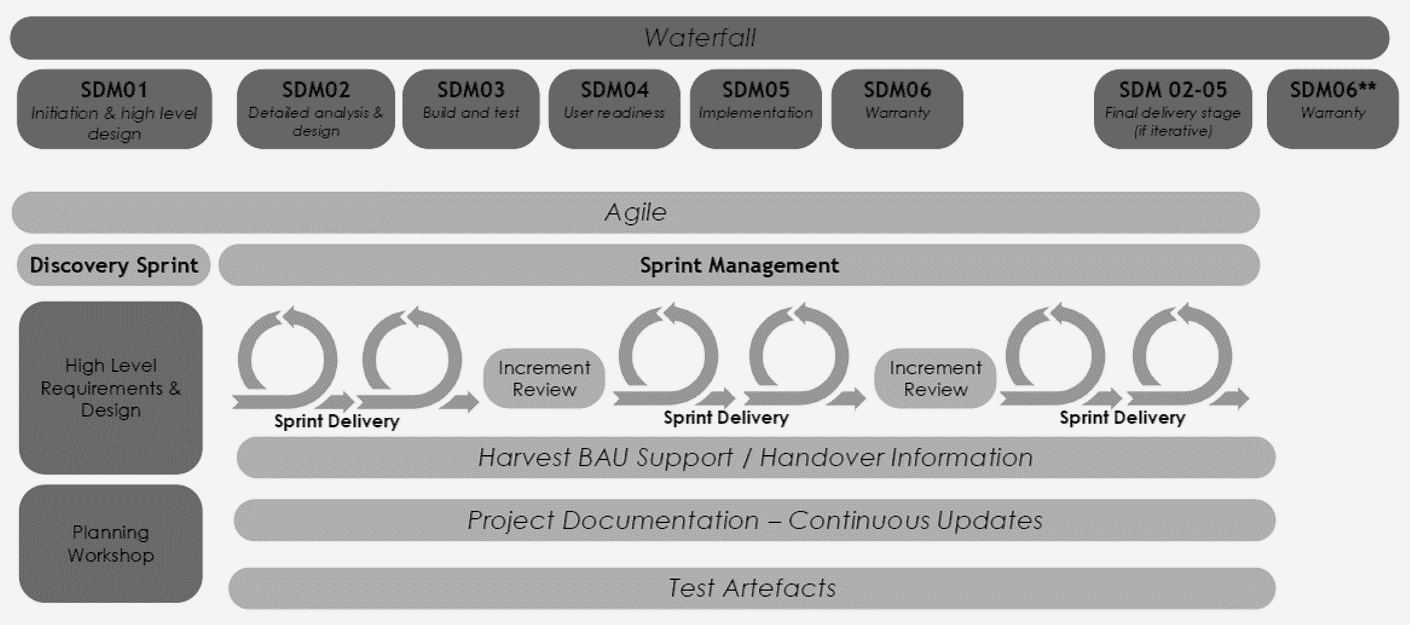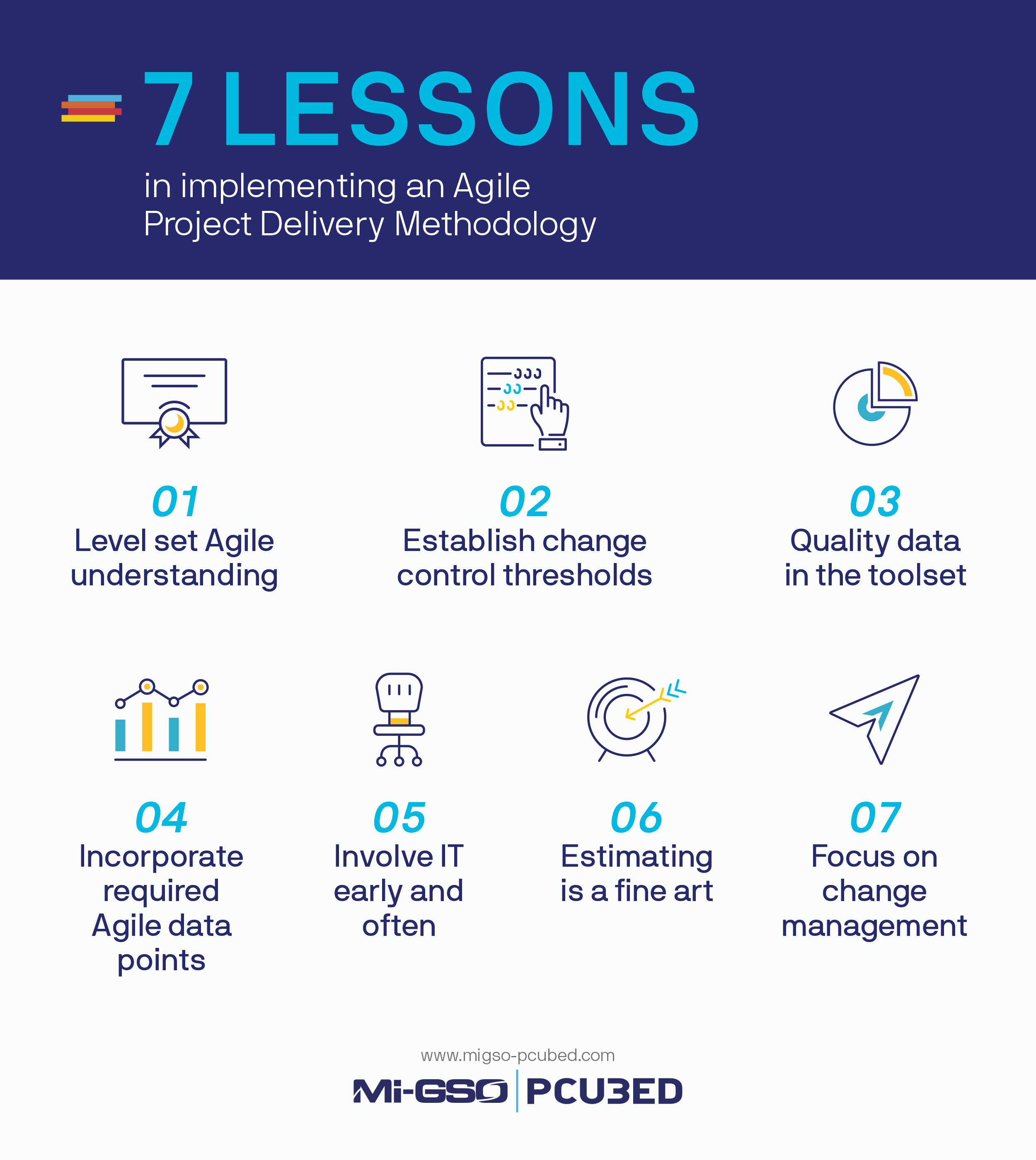Our website is not supported on this browser
The browser you are using (Internet Explorer) cannot display our content.
Please come back on a more recent browser to have the best experience possible

In 2014, Agile crossed the chasm and went mainstream after years of use in a predominately IT based community. Then, it rapidly became a buzzword associated with Digital Transformation as numerous organizations examined the benefits of failing fast in an effort to compete in our new digital enterprise. While Agile may have become old news, the rate of adoption still varies by region and many organizations still wrestle with how to govern both traditional and Agile modes of operation within a single organization.
The Client was looking for our help to design a predictive (mainly Agile) approach that could fit into, yet not replace their overall existing PPM structure.
Developed an Agile Solution Delivery Methodology, including an initial project assessment, a “Discovery Sprint” and accompanying processes supporting both the traditional and Agile projects within the portfolio.
The Client went from no process to a bespoke defined Agile methodology in 6 weeks supporting their transition to a more modern and hybridized way of working.
MIGSO-PCUBED was recently engaged to implement Agile into an organization’s existing solution delivery methodology within their overall project, program and portfolio management framework. The existing framework was a more traditional approach – or one heavily focused on a waterfall delivery. The client, the Director of IT Assurance and Governance was looking for our help to design a predictive (mainly Agile) approach that could fit into, yet not replace their overall existing PPM structure.
As the engagement was initiated by the Governance function, the focus was on how Agile project delivery could be assured with control points in place, not something traditionally synonymous with an Agile approach.
Coined by Gartner, “bi-modal”, also referred to also hybrid or adaptive, is the practice of managing separate modes of work: one focused on stable or predictable work i.e. traditional; the other more predictive, focused on new innovations where failure, when learned from, is welcome.
There is an optimal adaptive envelope for each company.
MIGSO-PCUBED began the project with an Agile Assessment or Program Diagnostic to understand the optimal adaptive approach for the organization rather than relying on market buzzwords to dictate which mode of operation was dominant. In this case, our client wished for “evolution not revolution”. Therefore the approach to the engagement was to produce an initial conceptual view of how the Agile framework might look within their existing structure.
As with any large Business Transformation project, a fundamental aspect of the project focused on Change Management. The MIGSO-PCUBED team set up meetings with the key stakeholders to understand their current processes and documentation, and to gauge their level of awareness, desire and knowledge of Agile. In addition, the team wanted to judge their ability to successfully implement an Agile delivery approach.
Subsequent workshops and presentations were then held to ensure that the stakeholders were involved and informed, and to provide an opportunity to obtain valuable input as the process developed. This reinforcement completed the ADKAR Model. This Agile Diagnostic process allowed the team to gain rapid insights into how Agile might be integrated to create a mixed environment where Mode 1 dominates.
As a Scaled Agile Partner, we attended the Scaled Agile Summit. To stay abreast of the latest best practices, read our event recap including all the new SAFe® features.
With a general framework in place, MIGSO-PCUBED set out to review existing PPM processes, templates and artifacts. The review process involved modifying or replacing these as appropriate for the addition of the Agile Solution Delivery Methodology into the overall PPM structure.
There were a few key changes necessary to allow flexibility in mode operation for the organization.
We modified our Agile Assessment tool used during the diagnostic above, to provide an initial project assessment tool evaluating scope flexibility, collaboration levels, ease of communication, environmental conditions, suitability to incremental delivery and the team’s overall understanding of Agile; to determine whether a project was suitable for an Agile delivery or better suited to Waterfall. This assessment is now part of the Starting up a Project process (PRINCE2) for all new projects.

Second, the introduction of a Sprint 0 stage, or ‘Discovery Sprint’ as depicted on the left on the graphic above, was developed to establish the high-level business requirements, solution design and test strategy, as well as plan the sprints before commencing the sprint cycles. Significant efficiencies were found by reducing the numerous design documents being used for waterfall projects, with one high level end-to-end Solution Design document for Agile projects.
Next our team established an Increment Review process to enable assurance and ongoing alignment to standards and processes throughout the Project Sprint Cycles. 3 week sprints were agreed as a standard with the Increment Review being conducted after every 2 sprints.
Finally, the team revamped the Portfolio and Project level reporting to include Agile components like Cumulative Flow Diagrams and a Project Burnup Chart. The result was an Agile Solution Delivery Methodology that complemented but did not supplant the client’s existing PPM structur
As with any large Business Transformation program there were a few lessons learned along the way.

Successfully expediting delivery requires learning through “fast failure” and an iterative development approach with an engaged client. The Client went from no process to a bespoke defined Agile methodology in 6 weeks. With the adaptive framework in place, the organization was enabled to benefit from the flexibility, visibility and speed to market that delivering projects in an Agile way offers, while still ensuring that solid project delivery and a process framework were in place for resources to follow whether on an Agile or Traditional project.
Loved what you just read?
Let's stay in touch.
No spam, only great things to read in our newsletter.
We combine our expertise with a fine knowledge of the industry to deliver high-value project management services.
MIGSO-PCUBED is part of the ALTEN group.
Find us around the world
Australia – Canada – France – Germany – Italy – Mexico – The Netherlands – Portugal – Romania – South East Asia – Spain – Switzerland – United Kingdom – United States
© 2024 MIGSO-PCUBED. All rights reserved | Legal information | Privacy Policy | Cookie Settings | Intranet
Perfect jobs also result from great environments : the team, its culture and energy.
So tell us more about you : who you are, your project, your ambitions,
and let’s find your next step together.
Dear candidates, please note that you will only be contacted via email from the following domain: migso-pcubed.com. Please remain vigilant and ensure that you interact exclusively with our official websites. The MIGSO-PCUBED Team
Choose your language
Our website is not supported on this browser
The browser you are using (Internet Explorer) cannot display our content.
Please come back on a more recent browser to have the best experience possible
